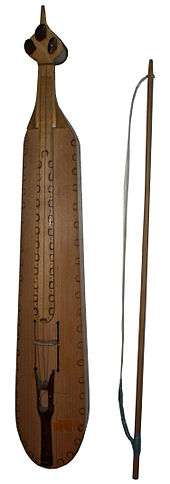Kemenche

.jpg)
Kemenche or kemençe is a name used for various types of stringed bowed musical instruments having their origin in the Eastern Mediterranean, particularly in Greece, Iran, Turkey, Armenia, and regions adjacent to the Black Sea. These instruments are folk instruments, generally having three strings and played held upright with their tail on the knee of the musician.[1] The name Kemençe derives from the Persian Kamancheh, and means merely "small bow".[2]
Variations
The Kemençe of the Black Sea (Turkish Karadeniz kemençesi, Greek Pontic kemenche, Pontic lyra, Ποντιακή λύρα) is a box-shaped lute (321.322), while the classical kemençe (or Klasik kemençe, Armudî kemençe, Politiki lyra; Greek: Πολίτικη Λύρα) is a bowl-shaped lute (321.321).
Other bowed instruments have names sharing the same Persian etymology include the kamancheh (or Kabak kemane in Turkish), a spike lute (321.31), and the Cappadocian kemane, an instrument closely related to the kemenche of the Black Sea with added sympathetic strings.
See also
References
- ↑ Hugo Pinksterboer, Tipbook: Cello (2002), p. 106.
- ↑ "Middle East Focus" (PDF). TheStrad.com: 50–52. July 2007. Archived from the original (PDF) on 2009-10-09.
The Persian word for bow is kaman, and kamancheh is the diminutive form.
External links
| Wikimedia Commons has media related to Kemenches. |